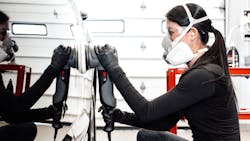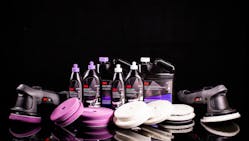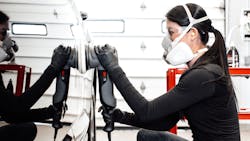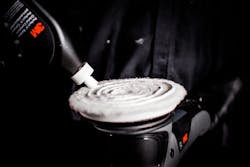Paint finishing is often one of the most feared steps in automotive repair. The goal, of course, is a show car shine, matching OEM textures perfectly to make it seem as if the car had never been touched. But given traditional rotary tools, reality is often different.
The finality of finishing can make bodywork intimidating to a newer tech. Sometimes a paint job gets ruined in the final stages of repair, which means a trip back to the booth and a longer cycle time. Unfortunately, customers don’t appreciate any visual reminders of the car’s mishaps, but they’re also notoriously impatient to get back to driving, so the pressure is on for a tech to get it right the first time.
“If the quality of that last step isn’t up to standard, the customer experience can take a hit,” said Jenny Thill, 3M global marketing manager. “But if the car looks absolutely fabulous, the shop’s reputation gains a boost. And it’s a win-win for the customer and the shop.”
Paint technicians like Donovan Starbuck appreciate the efficiency of the System. Starbuck, who works at Eddy’s Body Shop in Wichita, Kansas, says finishing is much faster.
“For an all-black car, I used to use a finishing compound that would most likely take me all day," Starbuck said. "With this System, it takes me two to three hours, which is really nice. It saves my back, too. With the old one, I could do four or five cars in a day. Now, I can do eight to nine cars if I really need to hustle.”
The System used to be exclusive to detailing shops but was recently re-engineered for the collision repair space. A lot of research and consideration went into making sure the tool would stand up to the varying conditions seen in collision repair shops. This System works well for both freshly painted cars and cured paint that’s seen some miles. It’s also versatile and adaptable enough to handle whatever the job is for the day. Even buffing out minor scratches and replacing them with a showroom shine can make a big difference in the car’s presentation, helping to lead to more satisfied customers.
The System is backed by a brand that knows collision repair. Each 3M product has been scientifically developed for the highest performance during defect removal, scratch refinement, compounding, buffing and polishing. 3M has put decades of technology to work in these paint finishing products including the pads, abrasives, liquids, and the tool itself.
The star of the show is the 3M Random Orbital Polisher, a tool that uses a combined circular and oscillating motion. While swirls from traditional rotary tools can stand out, the random motion of the Random Orbital Polisher eliminates dreaded swirl marks, even on dark finishes. The key difference is the motion of the tool: a rotary tool rotates in one specific direction uniformly, whereas the Random Orbital tool rotates and oscillates, and when partnered with 3M’s specially designed pads and liquids, can help to deliver superior results.
“Darker colors are hard to finish with just an orbital buffer,” explained Michael Castro, who manages quality control at Eurotech Refinishing & Collision in Bellflower, California. “We’ve even had customers complain because they see halos or swirls. With this new system, even the dark colors look really good.”
“The amount of compound I use on every vehicle has gone down,” says Starbuck. “It’s amazing. I can use two dabs on a spot 15 inches around. The different design of the tool keeps all the compound in the center spot. It’s an all-around great polisher.” “The polisher isn’t so messy,” adds Castro. “So, it’s easy to touch up and do things quick.”
3M Perfect-It products have been developed and tested according to a step-by-step system. There’s no need for a shop to create new processes or figure out a work-around for unexpected hiccups, since the System is validated and ready to go. Clear, simple directions walk users through the process, giving optimal tool speeds, pad types, liquid application levels and more. The videos are customized to the type of job, whether it be a full panel paint finish or just a quick and simple spot repair.
Premium product performance can mean shorter process times at every step. “If something’s too fresh and we need to do resurfacing or scratches, it takes me three to five minutes,” says Starbuck. “When we’re in a hurry, it’s great for a quick fix.”
Plus, the System is designed to be easy to learn, so managers and experienced techs can spend less time training new users. “The traditional rotary system takes a lot of skill to work a suave finish,” says Thill. “You can put this new tool in the hands of a novice, and they can deliver a high-quality paint job.”
Following a demo, Castro says it didn’t take long for his team to get comfortable. “Because it’s so easy to use, the guys just picked it up and started using it,” he says.
Having a user-friendly system that avoids issues like burn-through is critical. Clear coats are thin, especially on everyday economy cars. The only thing separating a high-powered tool and a vulnerable base coat is a paper-thin clear coat, just a few millimeters thick. What’s more, some clear coats are tough while others are soft. All of these factors can make burn through all too easy with a traditional rotary tool. And a burn through is an automatic trip back to the booth, which means longer cycle times and impatient customers.
“We do all our polishing in the morning. If you have seven cars to paint, you have to get them all done,” says Castro. “If you don’t, you lose another day of cycle. We can’t wait a whole day to give our cars back to our department.”
While rework is frustrating on a personal level, it’s also costly from a business perspective. Managers often find that the time to finish a car eats into their shop’s efficiency. Most auto shops are small and don’t have a lot of space to accommodate do-overs. According to AutoLeap’s 2022 report on the State of the Repair Industry, 59 percent of shops have five or fewer service bays.
“A lot of collision shops aren’t even compensated by insurance companies for finishing,” Thill said. “That last step can create a significant bottleneck to get to other vehicles quicker and turn more inventory.”
“The versatility of the tool, paired with the simplicity of the system, is a great solution for every repair shop,” says Thill.
With the 3M Perfect-It Random Orbital Polishing System, a shop can complete more jobs in the same amount of time, delivering the finest and most consistent finishes. That means better throughput and satisfied customers with every job. When new techs can get a defect-free finish without fear of burn-through, shop managers everywhere can breathe a sigh of relief.
“I was skeptical when I saw it, thinking how much good could it do?” recalled Castro. “But now I don’t even know how we did it before. It’s a game-changer.”





